CHAPTER 1
Introduction
Practice Questions
Problem 1.8.
Suppose you own 5,000 shares that are worth $25 each. How can put options be used to
provide you with insurance against a decline in the value of your holding over the next four
months?
You should buy 50 put option contracts (each on 100 shares) with a strike price of $25 and an
expiration date in four months. If at the end of four months the stock price proves to be less
than $25, you can exercise the options and sell the shares for $25 each.
Problem 1.9.
A stock when it is first issued provides funds for a company. Is the same true of an
exchange-traded stock option? Discuss.
An exchange-traded stock option provides no funds for the company. It is a security sold by
one investor to another. The company is not involved. By contrast, a stock when it is first
issued is sold by the company to investors and does provide funds for the company.
Problem 1.10.
Explain why a futures contract can be used for either speculation or hedging.
If an investor has an exposure to the price of an asset, he or she can hedge with futures
contracts. If the investor will gain when the price decreases and lose when the price increases,
a long futures position will hedge the risk. If the investor will lose when the price decreases
and gain when the price increases, a short futures position will hedge the risk. Thus either a
long or a short futures position can be entered into for hedging purposes.
If the investor has no exposure to the price of the underlying asset, entering into a futures
contract is speculation. If the investor takes a long position, he or she gains when the asset’s
price increases and loses when it decreases. If the investor takes a short position, he or she
loses when the asset’s price increases and gains when it decreases.
Problem 1.11.
A cattle farmer expects to have 120,000 pounds of live cattle to sell in three months. The
live-cattle futures contract on the Chicago Mercantile Exchange is for the delivery of 40,000
pounds of cattle. How can the farmer use the contract for hedging? From the farmer’s
viewpoint, what are the pros and cons of hedging?
The farmer can short 3 contracts that have 3 months to maturity. If the price of cattle falls, the
gain on the futures contract will offset the loss on the sale of the cattle. If the price of cattle
rises, the gain on the sale of the cattle will be offset by the loss on the futures contract. Using
futures contracts to hedge has the advantage that it can at no cost reduce risk to almost zero.
Its disadvantage is that the farmer no longer gains from favorable movements in cattle prices.
�
Problem 1.12.
It is July 2013. A mining company has just discovered a small deposit of gold. It will take six
months to construct the mine. The gold will then be extracted on a more or less continuous
basis for one year. Futures contracts on gold are available on the New York Mercantile
Exchange. There are delivery months every two months from August 2013 to December 2014.
Each contract is for the delivery of 100 ounces. Discuss how the mining company might use
futures markets for hedging.
The mining company can estimate its production on a month by month basis. It can then short
futures contracts to lock in the price received for the gold. For example, if a total of 3,000
ounces are expected to be produced in September 2014 and October 2014, the price received
for this production can be hedged by shorting a total of 30 October 2014 contracts.
Problem 1.13.
Suppose that a March call option on a stock with a strike price of $50 costs $2.50 and is held
until March. Under what circumstances will the holder of the option make a gain? Under
what circumstances will the option be exercised? Draw a diagram showing how the profit on
a long position in the option depends on the stock price at the maturity of the option.
The holder of the option will gain if the price of the stock is above $52.50 in March. (This
ignores the time value of money.) The option will be exercised if the price of the stock is
above $50.00 in March. The profit as a function of the stock price is shown in Figure S1.1.
Profit
20
30
40
50
60
70
Stock Price
20
15
10
5
0
-5
Figure S1.1 Profit from long position in Problem 1.13
Problem 1.14.
Suppose that a June put option on a stock with a strike price of $60 costs $4 and is held until
June. Under what circumstances will the holder of the option make a gain? Under what
circumstances will the option be exercised? Draw a diagram showing how the profit on a
short position in the option depends on the stock price at the maturity of the option.
The seller of the option will lose if the price of the stock is below $56.00 in June. (This
ignores the time value of money.) The option will be exercised if the price of the stock is
below $60.00 in June. The profit as a function of the stock price is shown in Figure S1.2.
�
60
50
40
30
20
10
0
0
-10
Profit
20
40
60
80
100
120
Stock Price
Figure S1.2 Profit from short position in Problem 1.14
Problem 1.15.
It is May and a trader writes a September call option with a strike price of $20. The stock
price is $18, and the option price is $2. Describe the investor’s cash flows if the option is
held until September and the stock price is $25 at this time.
The trader has an inflow of $2 in May and an outflow of $5 in September. The $2 is the cash
received from the sale of the option. The $5 is the result of the option being exercised. The
investor has to buy the stock for $25 in September and sell it to the purchaser of the option
for $20.
Problem 1.16.
An investor writes a December put option with a strike price of $30. The price of the option is
$4. Under what circumstances does the investor make a gain?
The investor makes a gain if the price of the stock is above $26 at the time of exercise. (This
ignores the time value of money.)
Problem 1.17.
The CME Group offers a futures contract on long-term Treasury bonds. Characterize the
investors likely to use this contract.
Most investors will use the contract because they want to do one of the following:
a) Hedge an exposure to long-term interest rates.
b) Speculate on the future direction of long-term interest rates.
c) Arbitrage between the spot and futures markets for Treasury bonds.
Problem 1.18.
An airline executive has argued: “There is no point in our using oil futures. There is just as
much chance that the price of oil in the future will be less than the futures price as there is
that it will be greater than this price.” Discuss the executive’s viewpoint.
�
It may well be true that there is just as much chance that the price of oil in the future will be
above the futures price as that it will be below the futures price. This means that the use of a
futures contract for speculation would be like betting on whether a coin comes up heads or
tails. But it might make sense for the airline to use futures for hedging rather than speculation.
The futures contract then has the effect of reducing risks. It can be argued that an airline
should not expose its shareholders to risks associated with the future price of oil when there
are contracts available to hedge the risks.
Problem 1.19.
“Options and futures are zero-sum games.” What do you think is meant by this statement?
The statement means that the gain (loss) to the party with the short position is equal to the
loss (gain) to the party with the long position. In total, the gain to all parties is zero.
Problem 1.20.
A trader enters into a short forward contract on 100 million yen. The forward exchange rate
is $0.0080 per yen. How much does the trader gain or lose if the exchange rate at the end of
the contract is (a) $0.0074 per yen; (b) $0.0091 per yen?
a) The trader sells 100 million yen for $0.0080 per yen when the exchange rate is $0.0074
per yen. The gain is 100 0 0006
× .
millions of dollars or $60,000.
b) The trader sells 100 million yen for $0.0080 per yen when the exchange rate is $0.0091
per yen. The loss is 100 0 0011
× .
millions of dollars or $110,000.
Problem 1.21.
A trader enters into a short cotton futures contract when the futures price is 50 cents per
pound. The contract is for the delivery of 50,000 pounds. How much does the trader gain or
lose if the cotton price at the end of the contract is (a) 48.20 cents per pound; (b) 51.30 cents
per pound?
a) The trader sells for 50 cents per pound something that is worth 48.20 cents per pound.
Gain = ($0.5000 − $0.4820) × 50,000 = $900.
b) The trader sells for 50 cents per pound something that is worth 51.30 cents per pound.
Loss = ($0.5130 − $0.5000) × 50,000 = $650.
Problem 1.22.
A company knows that it is due to receive a certain amount of a foreign currency in four
months. What type of option contract is appropriate for hedging?
A long position in a four-month put option can provide insurance against the exchange rate
falling below the strike price. It ensures that the foreign currency can be sold for at least the
strike price.
Problem 1.23.
A United States company expects to have to pay 1 million Canadian dollars in six months.
Explain how the exchange rate risk can be hedged using (a) a forward contract; (b) an option.
The company could enter into a long forward contract to buy 1 million Canadian dollars in
six months. This would have the effect of locking in an exchange rate equal to the current
�
forward exchange rate. Alternatively the company could buy a call option giving it the right
(but not the obligation) to purchase 1 million Canadian dollars at a certain exchange rate in
six months. This would provide insurance against a strong Canadian dollar in six months
while still allowing the company to benefit from a weak Canadian dollar at that time.
Problem 1.24
A trader buys a call option with a strike price of $30 for $3. Does the trader ever exercise the
option and lose money on the trade. Explain.
Yes, the trader will exercise if the asset price is greater than $30, but will cover the cost of the
call option only if the price is greater than $33. The trader exercises and loses money if the
price is between $30 and $33.
Problem 1.25
A trader sells a put option with a strike price of $40 for $5. What is the trader’s maximum
gain and maximum loss? How does your answer change if it is a call option?
The trader’s maximum gain from the put option is $5. The maximum loss is $35,
corresponding to the situation where the option is exercised and the asset price is zero. If the
option were a call, the trader’s maximum gain would still be $5, but there would be no bound
to the loss as there is in theory no limit to how high the asset price could rise.
Problem 1.26
‘‘Buying a stock and a put option on the stock is a form of insurance.’’ Explain this
statement.
If the stock price declines below the strike price of the put option, the stock can be sold for
the strike price.
Further Questions
Problem 1.27 (Excel file)
Trader A enters into a forward contract to buy an asset for $1000 an ounce in one year.
Trader B buys a call option to buy the asset for $1000 in one year. The cost of the option is
$100. What is the difference between the positions of the traders? Show the profit as a
function of the price of the asset in one year for the two traders.
Trader A makes a profit of ST ̶ 1000 and Trader B makes a profit of max(ST ̶ 1000,
0) –100 where ST is the price of the asset in one year. Trader A does better if ST is above
$900 as indicated in the diagram below
�
Profit
300
200
100
0
700
- 100
- 200
- 300
900
1100
1300
Asset Price
Trader A
Trader B
Problem 1.28
On June 25, 2012, as indicated in Table 1.2, the spot offer price of Google stock is $561.51
and the offer price of a call option with a strike price of $560 and a maturity date of
September is $30.70. A trader is considering two alternatives: buy 100 shares of the stock
and buy 100 September call options. For each alternative, what is (a) the upfront cost, (b)
the total gain if the stock price in September is $620, and (c) the total loss if the stock
price in September is $500. Assume that the option is not exercised before September and
if stock is purchased it is sold in September.
a) The upfront cost for the share alternative is $56,151. The upfront cost for the option
alternative is $3,070.
b) The gain from the stock alternative is $62,000−$56,151=$5,849. The total gain from
the option alternative is ($620-$560)×100−$3,070=$2,930.
c) The loss from the stock alternative is $56,151−$50,000=$6,151. The loss from the
option alternative is $3,070.
Problem 1.29
What is arbitrage? Explain the arbitrage opportunity when the price of a dually listed
mining company stock is $50 on the New York Stock Exchange and $52 CAD on the Toronto
Stock Exchange. Assume that the exchange rate is such that 1 USD equals 1.01 CAD.
Explain what is likely to happen to prices as traders take advantage of this opportunity.
Arbitrage involves carrying out two or more different trades to lock in a profit. In this case,
traders can buy shares on the NYSE and sell them on the TSX to lock in a USD profit of
52/1.01−50=1.485 per share. As they do this the NYSE price will rise and the TSX price will
fall so that the arbitrage opportunity disappears
Problem 1.30
In March, a US investor instructs a broker to sell one July put option contract on a stock. The
stock price is $42 and the strike price is $40. The option price is $3. Explain what the
investor has agreed to. Under what circumstances will the trade prove to be profitable? What
are the risks?
�
The investor has agreed to buy 100 shares of the stock for $40 in July (or earlier) if the party
on the other side of the transaction chooses to sell. The trade will prove profitable if the
option is not exercised or if the stock price is above $37 at the time of exercise. The risk to
the investor is that the stock price plunges to a low level. For example, if the stock price
drops to $1 by July (unlikely but possible), the investor loses $3,600. This is because the put
options are exercised and $40 is paid for 100 shares when the value per share is $1. This
leads to a loss of $3,900 which is offset by the premium of $300 received for the options.
Problem 1.31
A US company knows it will have to pay 3 million euros in three months. The current
exchange rate is 1.4500 dollars per euro. Discuss how forward and options contracts can be
used by the company to hedge its exposure.
The company could enter into a forward contract obligating it to buy 3 million euros in three
months for a fixed price (the forward price). The forward price will be close to but not
exactly the same as the current spot price of 1.4500. An alternative would be to buy a call
option giving the company the right but not the obligation to buy 3 million euros for a a
particular exchange rate (the strike price) in three months. The use of a forward contract locks
in, at no cost, the exchange rate that will apply in three months. The use of a call option
provides, at a cost, insurance against the exchange rate being higher than the strike price.
Problem 1.32 (Excel file)
A stock price is $29. An investor buys one call option contract on the stock with a strike price
of $30 and sells a call option contract on the stock with a strike price of $32.50. The market
prices of the options are $2.75 and $1.50, respectively. The options have the same maturity
date. Describe the investor's position.
This is known as a bull spread and will be discussed in Chapter 11. The profit is shown in the
diagram below
�
Problem 1.33
The price of gold is currently $1,800 per ounce. Forward contracts are available to buy or
sell gold at $2,000 per ounce for delivery in one year. An arbitrageur can borrow money at
5% per annum. What should the arbitrageur do? Assume that the cost of storing gold is zero
and that gold provides no income.
The arbitrageur should borrow money to buy a certain number of ounces of gold today and
short forward contracts on the same number of ounces of gold for delivery in one year. This
means that gold is purchased for $1800 per ounce and sold for $2000 per ounce. The cost of
the borrowing is $90 per ounce. A riskless profit of $110 per ounce is generated.
Problem 1.34.
Discuss how foreign currency options can be used for hedging in the situation described in
Example 1.1 so that (a) ImportCo is guaranteed that its exchange rate will be less than
1.5800, and (b) ExportCo is guaranteed that its exchange rate will be at least 1.5400.
ImportCo can buy call options on $10,000,000 with a strike price of 1.5800. This will ensure
that it never pays more than $15,800,000 for the sterling it requires. ExportCo can buy put
options on $30,000,000 with a strike price of 1.5400. This will ensure that the price received
for the sterling will be above
Problem 1.35.
The current price of a stock is $94, and three-month call options with a strike price of $95
currently sell for $4.70. An investor who feels that the price of the stock will increase is
trying to decide between buying 100 shares and buying 2,000 call options (20 contracts).
Both strategies involve an investment of $9,400. What advice would you give? How high does
the stock price have to rise for the option strategy to be more profitable?
The investment in call options entails higher risks but can lead to higher returns. If the stock
price stays at $94, an investor who buys call options loses $9,400 whereas an investor who
buys shares neither gains nor loses anything. If the stock price rises to $120, the investor who
buys call options gains
×
An investor who buys shares gains
The strategies are equally profitable if the stock price rises to a level, S , where
or
The option strategy is therefore more profitable if the stock price rises above $100.
Problem 1.36.
On June 25, 2012, an investor owns 100 Google shares. As indicated in Table 1.3, the bid
share price is $561.32 and a December put option with a strike price $520 costs $26.10. The
2000 (120 95) 9400
95) 9400
$
40 600
100 (120 94)
×
−
,000,30
000
,46$
00,200
$
2 600
,
2000(
S
100 (
×
S
54.1
×
S =
100
=
−
94)
=
,
−
−
−
−
.
=
=
�
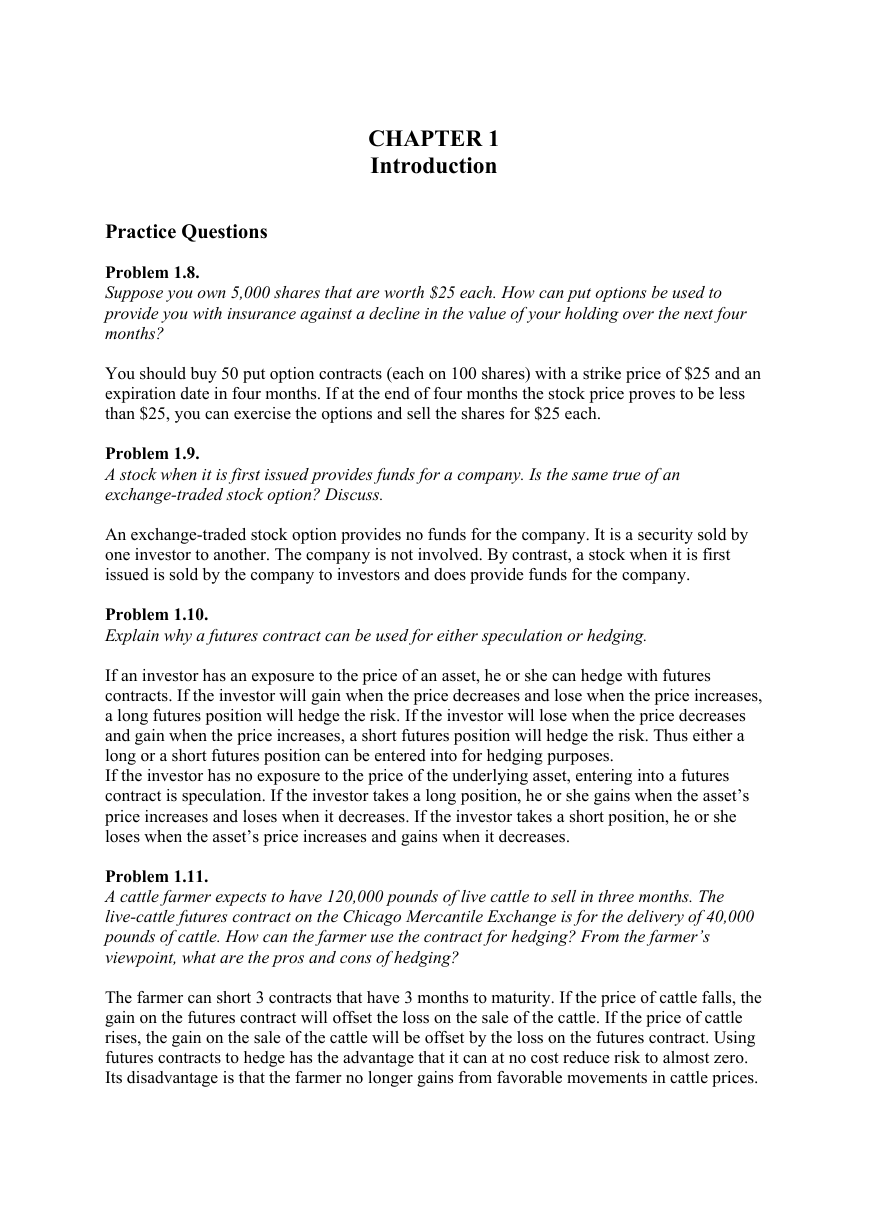
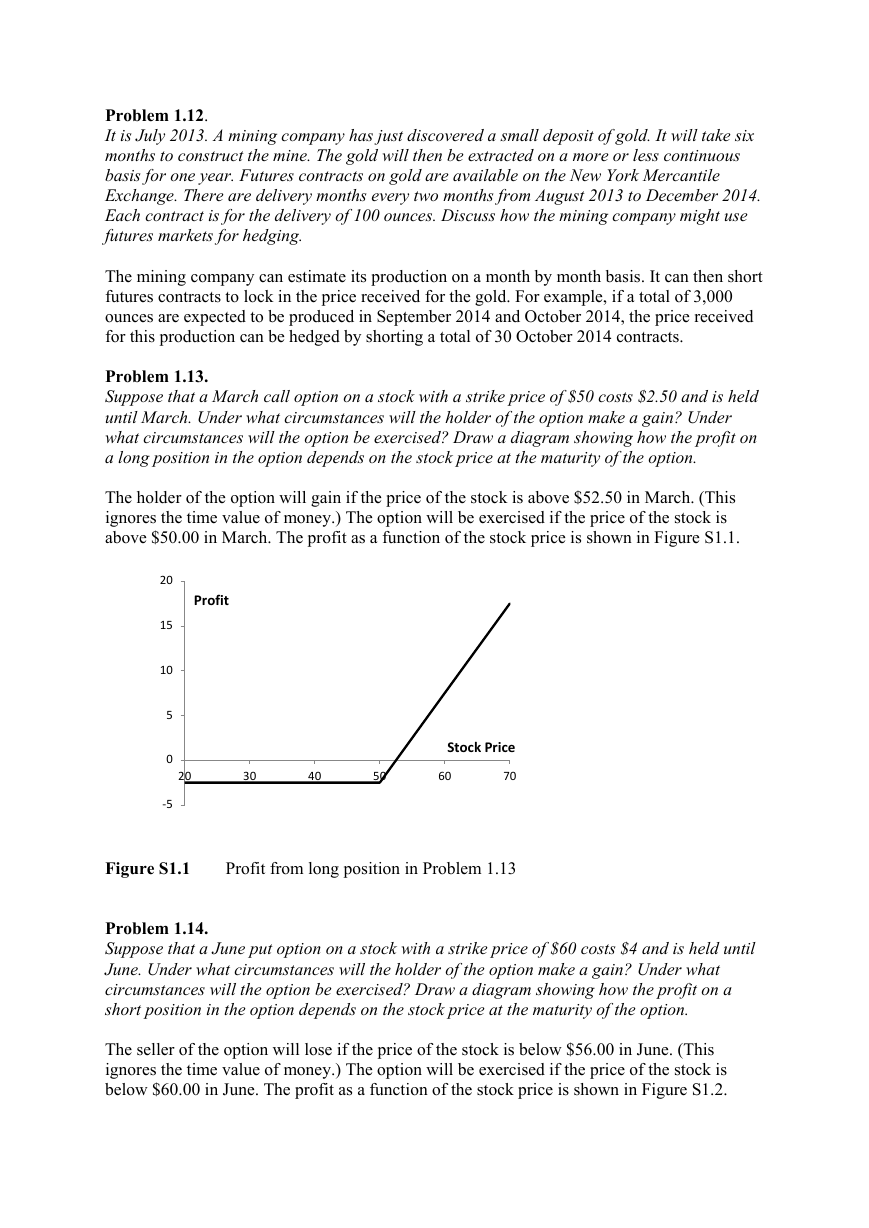
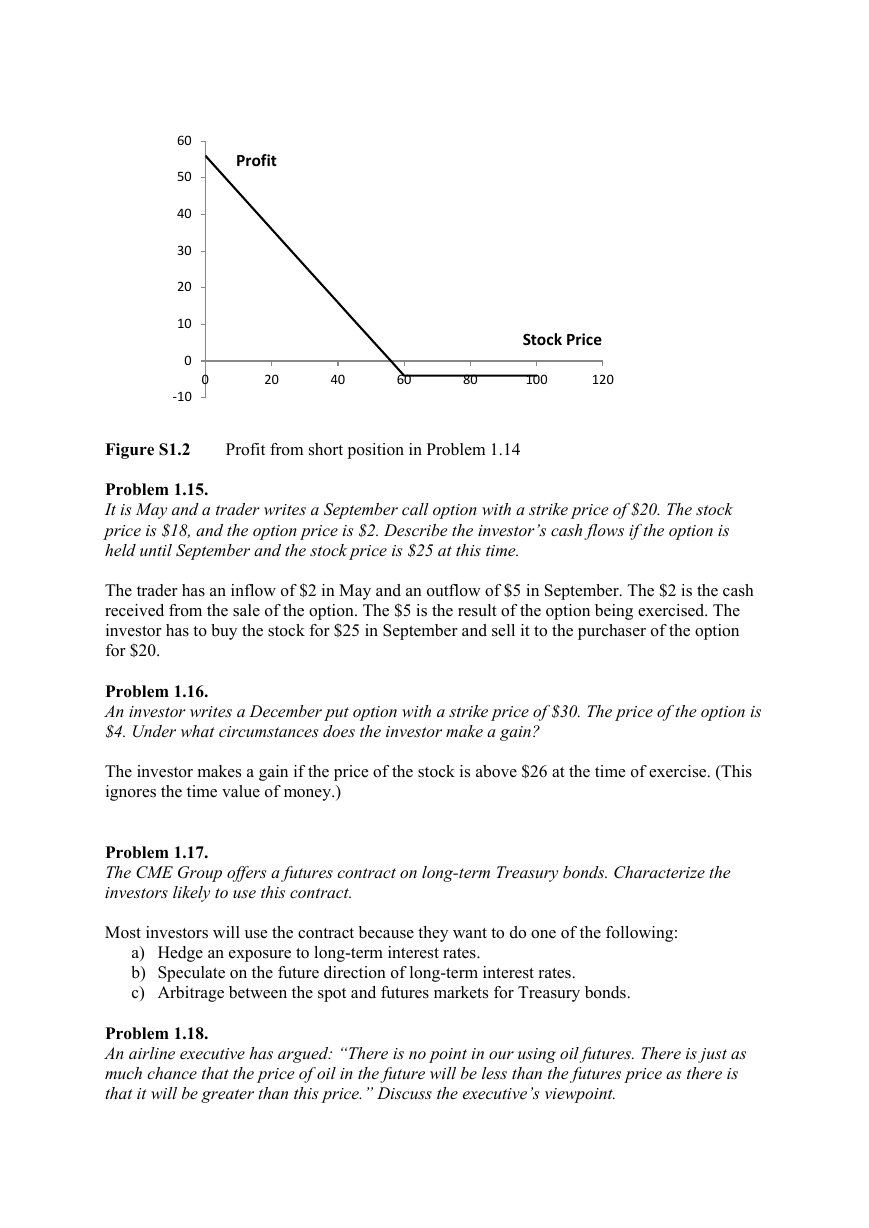

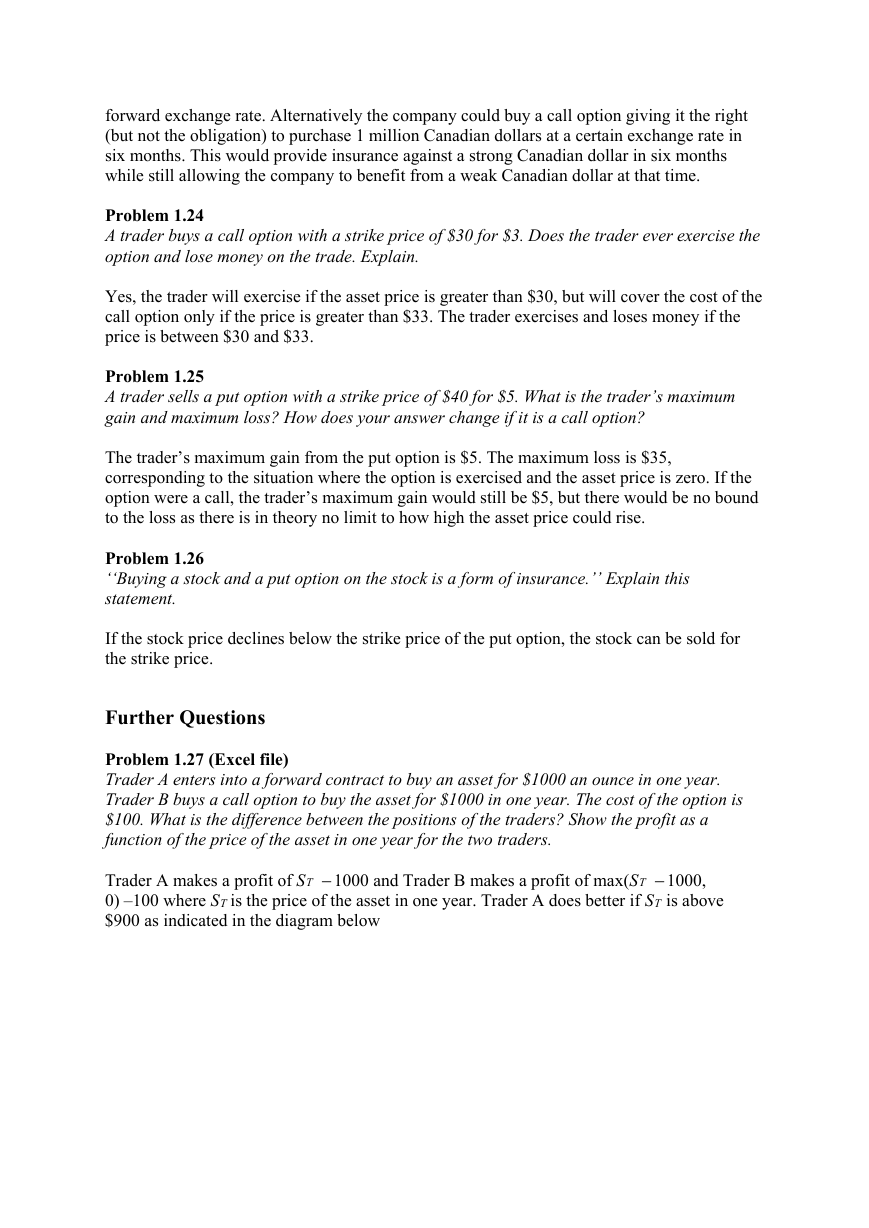
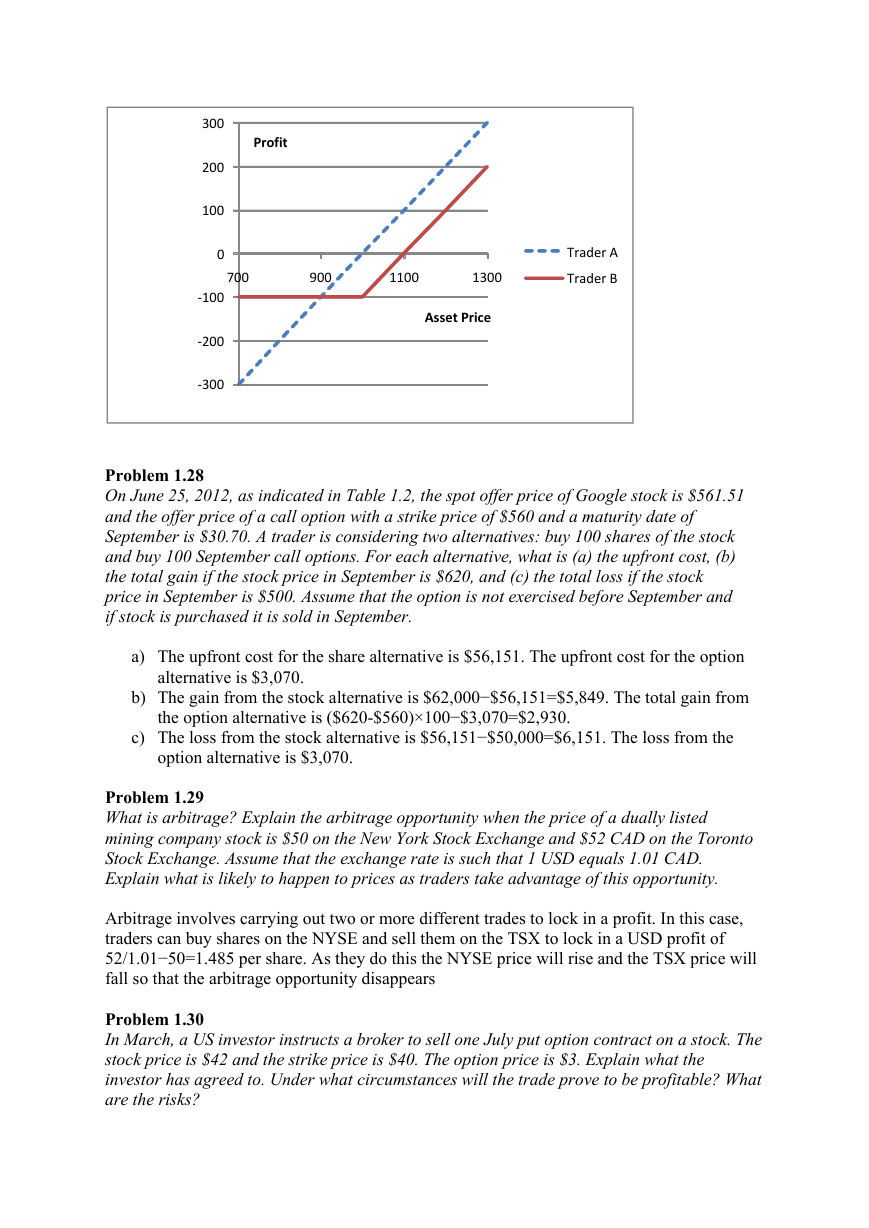










 2023年江西萍乡中考道德与法治真题及答案.doc
2023年江西萍乡中考道德与法治真题及答案.doc 2012年重庆南川中考生物真题及答案.doc
2012年重庆南川中考生物真题及答案.doc 2013年江西师范大学地理学综合及文艺理论基础考研真题.doc
2013年江西师范大学地理学综合及文艺理论基础考研真题.doc 2020年四川甘孜小升初语文真题及答案I卷.doc
2020年四川甘孜小升初语文真题及答案I卷.doc 2020年注册岩土工程师专业基础考试真题及答案.doc
2020年注册岩土工程师专业基础考试真题及答案.doc 2023-2024学年福建省厦门市九年级上学期数学月考试题及答案.doc
2023-2024学年福建省厦门市九年级上学期数学月考试题及答案.doc 2021-2022学年辽宁省沈阳市大东区九年级上学期语文期末试题及答案.doc
2021-2022学年辽宁省沈阳市大东区九年级上学期语文期末试题及答案.doc 2022-2023学年北京东城区初三第一学期物理期末试卷及答案.doc
2022-2023学年北京东城区初三第一学期物理期末试卷及答案.doc 2018上半年江西教师资格初中地理学科知识与教学能力真题及答案.doc
2018上半年江西教师资格初中地理学科知识与教学能力真题及答案.doc 2012年河北国家公务员申论考试真题及答案-省级.doc
2012年河北国家公务员申论考试真题及答案-省级.doc 2020-2021学年江苏省扬州市江都区邵樊片九年级上学期数学第一次质量检测试题及答案.doc
2020-2021学年江苏省扬州市江都区邵樊片九年级上学期数学第一次质量检测试题及答案.doc 2022下半年黑龙江教师资格证中学综合素质真题及答案.doc
2022下半年黑龙江教师资格证中学综合素质真题及答案.doc